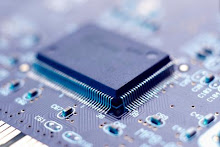 Meet MSI's P55-GD80, the company's highest-end P55-based offering, expected to run right around $200. As with many past MSI platforms, this one sports tasteful aesthetic touches, like black and dark blue components, classy, unobstructed cooling on the voltage regulation circuitry, and an oversized anodized-looking heatpipe.
Meet MSI's P55-GD80, the company's highest-end P55-based offering, expected to run right around $200. As with many past MSI platforms, this one sports tasteful aesthetic touches, like black and dark blue components, classy, unobstructed cooling on the voltage regulation circuitry, and an oversized anodized-looking heatpipe.
In this preview, we'll explore MSI's flagship in greater depth and then introduce ASRock's upcoming top-end model as well. Representatives from ASRock recently spent the afternoon in our Bakersfield, California lab to talk about P55 plans, pricing, power, and future technologies--I'll give you more detail as we skirt around the company's P55 Deluxe.
But first, let's dive into the P55-GD80, a board we're expecting to be a hit with the overclocking community and will evaluate in greater depth once Intel's upcoming platform officially debuts...

You'll find no surprises here: two legacy PS/2 ports, coaxial/optical digital audio outputs, FireWire 400, plenty of USB 2.0, eSATA (with a powered USB port), dual Gigabit Ethernet jacks, and analog audio connectivity constitute the board's basic back-panel I/O.

MSI's V-Check Points facilitate easy readings if you have a multimeter and want to take your own voltage measurements. To the left of that block, you'll find a bank of DIP switches used to unlock more aggressive voltage options in the board's BIOS.
As with most other P55 boards, the P55-GD80 proffers four DDR3 memory slots supporting dual-channel configurations running at speeds as high as 1,333 MT/s. The slots themselves are color-coded to ensure you install modules correctly.
We've actually spent some quality time with MSI's OC Dial feature, which worked well on the company's 790FX-GD70. OC Genie actually handles the overclocking process automatically by altering Bclk settings in the BIOS through a hardware-based IC. More than likely, this is something mainstream folks might be tempted to play with, but we're pretty confident that power users will choose to set their own parameters. Fortunately, two on-board Direct OC buttons facilitate 1 MHz Bclk adjustments in either direction.
Underneath the Direct OC and OC Genie buttons, you'll find Green Power, reset, and power icons silk screened onto the PCB. Those are actually touch-sensitive buttons that light up when activated, similar to the power button on a PS3. MSI calls the feature Easy Button 2, and we dig it.
With support for CrossFire and SLI, the first two PCI Express x16 slots on MSI's P55-GD80 are tied to the LGA 1156 interface. With one graphics card installed, the top slot gets all 16 of the CPU's available lanes. With two installed, the slots automatically revert to x8/x8. The third x16 slot runs to the P55 PCH and is wired to operate at x4 signaling rates. Bear in mind that if you populate the third slot, neither of the x1 slots will be usable. Why not? Doesn't P55 include eight lanes of PCI Express 2.0? Yes, it does. But MSI's integrated extras (networking/storage) utilize what's left. So, just keep the slot limitations in mind as you plan your upgrade path.
Two standard PCI slots round out expansion on the P55-GD80.
Several vendors claim to optimize intricate power circuits, switching phases on and off as needed. MSI's implementation (which centers on a relatively-conservative eight phase hardware design) is complemented by an LCD readout indicating exactly how many power phases are being used at any given time.
Given that the Core i5 and Core i7 processors launching next month are 95W parts, we suspect that MSI's decision to go eight-phase, even when competing vendors are deploying as many as 24, is probably a safe bet. We've already taken a pre-production i5 up past 4.1 GHz on this board without any sort of issue. And we know from discussions with Intel that lower phase counts, designed properly, can be just as effective as more complex solutions.
MSI covers its MOSFETs with beefy heatsinks and a substantial heatpipe. This cooling circuit, dubbed SuperPipe, is designed to draw heat away from on-
board components and move it to less-sensitive areas of the motherboard. The heatsink on the left in the above picture doesn't actually rest on vital core logic. Rather, it's in place to help keep power circuitry cooler. We've seen similar designs from other vendors and questioned the necessity of extra cooling on a cost-conscious d
esign. However, at a sub-$200 price, we're willing to test the effectiveness of SuperPipe when it comes time to round up the higher-end P55 platforms.
Most of the features highlighted on MSI's P55-GD80 center on drawing in the enthusiast crowd. However, "True Blu-ray Audio" silk-screened onto the PCB caught our attention, too. So, what does that mean, exactly?
As far as we're able to tell, it's a reference to the integrated Realtek ALC889 audio codec. CyberLink's PowerDVD 9 playback app supports the ALC889 (among four other HD Audio codecs) and offers up to 96 kHz / 24-bit audio playback through eight analog channels. It won't do lossless pass-through, like Asus' Xonar HDAV 1.3 , but there is truth to MSI's claim for high-def support if you're using the right playback application and speaker configuration.






